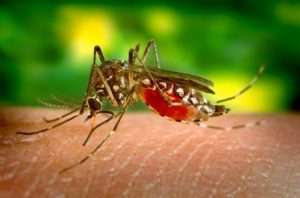HOW TO RECOGNIZE MOSQUITOES

WHERE DO MOSQUITOES COME FROM
Mosquitoes come from any bodies of standing water outside. Examples are:
- Pet food and water bowls left outside
- Flower pot overflow trays
- Abandoned tires
- Soft drink cans and bottles that collect water
- Bird baths
- Water gardens
- Drainage ditches
- Permanent or temporary pools
- Tree holes
- Rainwater catch basins
- And any other places where standing water is present
**Exceptions are flowing streams and open waters of rivers and lakes.
THE BIOLOGY AND BEHAVIOR OF MOSQUITOES
The mosquito most people encounter in central NC is the Asian tiger mosquito, Aedes albopictus. It is native to tropical and subtropical areas of Southeast Asia but has dispersed worldwide through the transport of goods and international travelers. It is an aggressive, daytime biter recognizable by its relatively small size and a bearing a single white stripe on its back (Figure 1).
Mosquitoes undergo four development stages: egg, larva, pupa, and adult. The first three are mainly aquatic. In North Carolina, each stage lasts from 5-14 days depending on temperature.
Most female mosquitoes lay their eggs in stagnant water, but some, like the Asian tiger mosquito, lay their eggs in areas above the waterline. These eggs only hatch when they become inundated, usually with rainwater. Consequently, they can withstand long periods of dry weather.
Once the females emerge and mate with the male, they immediately begin searching for a host from which to get blood. Hosts include mammals (including people), birds, reptiles, amphibians, and in rare cases, fish. The Asian tiger mosquito has become a real nuisance because it is more closely associated with people than other species of mosquitoes. It feeds from dawn to dusk.
WAYS TO REDUCE CONDITIONS THAT HARBOR AND ATTRACT MOSQUITOES
- Change the water frequently in pet bowls
- Punch holes in tires to drain the standing water
- Collect and discard or recycle bottles and cans holding water
- Repair sagging or plugged gutters
- Change water in bird baths, flower pot trays
- Fill with sand any receptacles capable of holding standing water
Economy Exterminators can help you with your Mosquito problem
- Economy offers a Mosquito Control Service
- We use the best materials available
- Applications made every 60 days
- Re-application is available at no charge
- We will offer you suggestions for real solutions to reduce the breeding sites on our property
Call our offices to schedule an inspection of your property.






